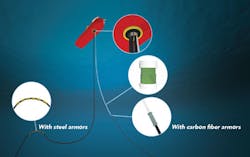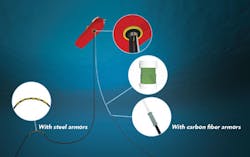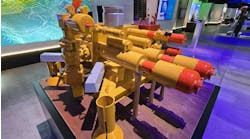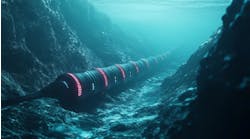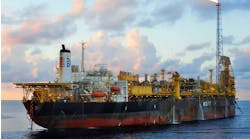Jeremy Beckman
Editor-Europe
Although deepwater activity has slowed over the past year, subsea contractors continue to prepare for the upturn. At a recent presentation in London, Technip outlined some of the technologies it is working on to extend the lives of producing subsea facilities and to extend development to deeper water.
According to Laurent Décoret, Group Senior VP Innovation & Technology, the challenges preoccupying offshore operators include aging infrastructure; the need for life-of-field monitoring and inspection systems; flow assurance and recovery from complex reservoirs that are more difficult to produce, with a requirement for active heating to put energy into the fluid; and problematic reservoir conditions such as high pressure/high temperature, with carbon dioxide (CO2) or hydrogen sulfide (H2S) in the fluids, and the requirement for products that can accommodate these components.
For ultra-deepwater developments such as the presalt fields off Brazil, the design life can be 30 years-plus, Décoret pointed out. “Our products must sustain production without the need for intervention over this period,” he said. “And increasingly, new technology must generate cost savings for clients.”
In October, Technip USA signed an agreement with 3D at Depth, based in Boulder, Colorado, to jointly develop the LIDAR (Light Detection and Ranging) laser scanning technology for new types of subsea metrology and inspection applications. LIDAR can be used to build precise 3D models of subsea structures, including in deepwater where data collection and imaging is typically more difficult. The technique can be applied to more accurately assess requirements for connecting pipelines to wells and manifolds prior to fabricating spools, speeding the operation and minimizing any work that might subsequently need to be re-done.
Another issue Technip has been working on is an improved methodology for assessing riser fatigue, particularly in the presalt plays where risers can typically be suspended up to 2,500 m (8,203 ft) from an FPSO to the seafloor. “To minimize top-section tension, buoyancy modules have to be fitted along the riser,” Décoret explained. “These have to be procured and they then take time to install. It would be better to be able to unreel a flexible riser with nothing on it and reduce significantly the number of buoyancy modules. This is a challenge the company is addressing to provide flexible pipes on the Libra field in the Santos basin, notably for the high pressure gas injection application.”
Technip’s longest established flexible manufacturing plant is in Le Trait, northern France. Here it has introduced Cowbot (CObot for Wire Bending Operation at Technip), a machine designed to improve the wire bending process during end-fitting mounting operations, reducing effort for the machine operators and ensuring better repeatability. As the industry moves ever deeper toward production in 4,000 m (13,123 ft) water depth, with the attendant higher pressures, this will add to the strains imposed on the riser by the movement of the FPSO. That can be partly addressed via adding reliability during the end fitting mounting process, Décoret said.
At the same time, there is a general recognition that composites will be needed to replace steel sections for risers to withstand the stresses of deeper-water service. Technip has been working on carbon fiber armor that would provide higher mechanical strength than flexible pipes with tensile steel armors while reducing weight by up to 50%. “That would be significant for a riser in 4,000 m of water,” Décoret pointed out, “and with this armor, we could get rid of buoyancy altogether. The result would be a free-hanging riser that is slightly shorter. And although composites cost more to manufacture than steel, without buoyancy this solution would be easier to install, and therefore cost-effective.”
The company has qualified the first generation of carbon armor. “There is a limit on the maximum temperature it can withstand, but we are working on second and third-generation versions to address this. And we are also studying use of composite materials for umbilical and rigid pipeline systems as well as to replace other layers within the flexible pipe.”
Another ongoing development is Morphopipe, which involves inserting microelectronic sensors in the top section of risers or umbilicals to provide life of service performance feedback. This could include the curvature of the riser at the connection point to the offshore production facility for fatigue monitoring. “Bending of the pipe creates the most fatigue,” Décoret said. “With this technology, it could be possible to determine whether the pipe’s service can be extended beyond its design life, or if it has reached maximum capacity and therefore has to be removed.”
Decoret said Technip’s In-Service Riser Inspection (IRIS) system could provide a step-change in monitoring of in-service risers, and also umbilicals and rigid pipelines. This is a crawler module equipped with various different Non-Destructve Testing (NDT) technologies that would be deployed by an ROV. After clamping onto the riser, the crawler would perform tests to determine possible ingress of water or breakage of armor wire, supervised remotely from a control room. The crawler would send out a unique (according to Décoret) combination of ultrasonic signals and electromagnetic impulses that would be matched against what the control room operator would expect to receive to determine if there is a problem.
Another technique under development involves use of X-ray inspection to create a true 3D picture of an in-situ flexible riser, similar to the service provided by a hospital scanner. This could be applied to the top 200 m (656 ft) of the riser to determine whether any breakages, cracks or corrosion are taking place.
